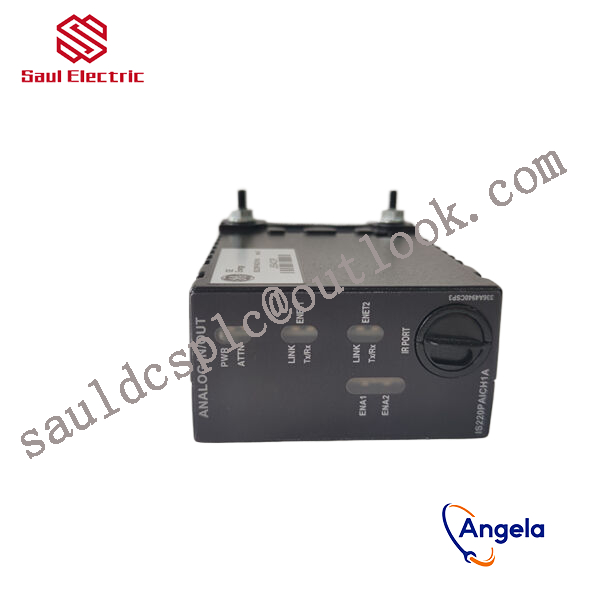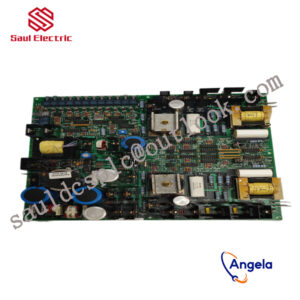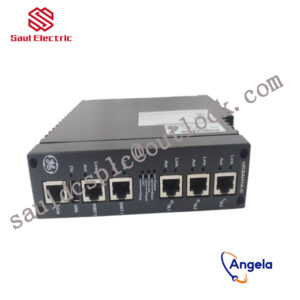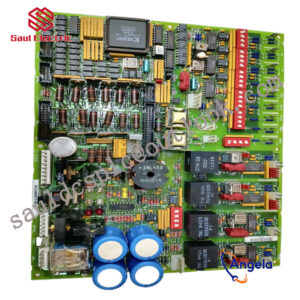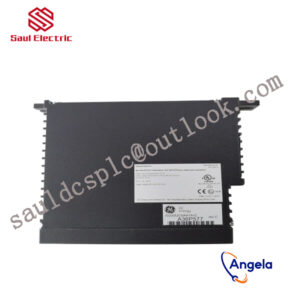Description
IS200DAMAG1A Product Introduction
The specific application scope of the product
will depend on the needs of system integration and industrial application, but generally speaking, this type of embedded controller module can be applied to the following categories:
manufacturing processes, etc.
monitoring and control system.
of the controller module, as well as the specific needs of the customer.
designed to manage gas or steam turbines.
It has a CIMPLICITY graphical interface and an HMI with software suitable for running heavy-duty turbines.
be installed at the bottom of the cabinet. For a small setup that is easy to serve a triple redundant system, up to three components can be installed side by side.
he board can operate within a temperature range of 0 to 65 degrees Celsius without the need for a fan for cooling. NFPA Class 1. This board can be used for two applications.
Figure 4 Tool Framework2.3Smart component creationCall the Rotator component: This component is used to allow the rotatable grinding rotor to rotate during simulation to simulate the real grinding scene. In the parameters of the Rotator component, set the reference to object, the reference object to the frame l, and the object to a copy of the rotor. (2) The rotary grinding rotor can be rotated, and the speed is l20mm/s (the speed of the grinding head will affect the quality of the finished product) ), the reference center axis is: axis (based on frame l, centerpoint x, y,: set to 0, 0, 0, Axis set x, y,: 0, 0, l000mm).Call the Attach component: This component is used to allow the rotatable grinding rotor to be integrated with the tool body. When the tool body is installed on the flange, it can follow the movement of the flange. In the parameters of the Attach component, set the sub-object to be a copy of the rotor (2) for the rotatable polishing rotor, and the parent object is the tool body of a copy of the rotor. The offset and orientation are based on the offset of point B relative to the origin. For setting, you can use the measurement tool in Robotstudio software to measure, and then set the parameters after measurement.Verification: Install a copy of the rotor tool body onto the robot flange, and then click Execute in the Attach component. You can observe whether the position of the rotatable grinding rotor is correct at this time. If there is a deviation, adjust the position in time, as shown in the figure. 5 shown.Figure 5 Tool installation2.4 Create tool coordinate systemUse the six-point method to create the tool coordinate system Too1data on the robot teach pendant at the center of the rotor. Change the tool coordinate system to Too1data in the basic options. At this time, click on the robot manual linear and you can drag the robot to move linearly at will.2.5 Creating trajectories and programmingDetermine the trajectory: According to the requirements of the work task, design the grinding trajectory around the workpiece and determine the trajectory points and transition points required for the grinding trajectory. The grinding action process is shown in Figure 6.Setting I/O and programming: Yalong IY-l3-LA industrial robot deburring and grinding system control and application equipment adopts 0sDC-52 6/o communication board, the address is 10, Do1 is the digital output signal, the address is 1 . First set the I/O board, then set the I/O digital output signal Di1, and then program on the simulation teaching pendant. The procedure is as follows:PRoCmain()setDo1: Set the Do1 signal to allow the external grinding rotor to start rotating.waitTime1: The robot stays in place and does not move, waits for 1s, and lets the polishing rotor turn to the specified speed, transitionMoveAbsjjpos10NoEoffs,v1000,z50,Too1data1: The robot moves to the initial point jpos10 above point p10. Point jpos10 is used as the starting point and end point of the robot”s action.Move4p10,v1000,z50,Too1data1: Move straight line grinding to point p10Move4pL0,v1000,z50,Too1data1: Move straight line grinding to pL0 pointMove4p30,v1000,z50,Too1data1: Move straight line grinding to point p30Move4p40,v1000,z50,Too1data1: Move straight line grinding to p40 pointMove4p10,v1000,z50,Too1data1: Move straight line grinding to point p10MoveAbsjjpos10NoEoffs,v1000,z50,Too1data1: The robot moves to the initial point jpos10 above point p10waitTime1: wait 1s, transitionResetDo1: Reset the Do1 signal to stop the rotor ENDPRoC2.6 Simulation design and verificationSimulation design: Create a smart component to input the Di1 signal, and use the Di1 signal to simulate the external polishing start signal to execute the Rotator component and Attach component of the smart component to achieve the visual effect of rotating and polishing the polishing rotor. In the workstation logic design, the smart component input Di1 signal is associated with the robot Do1 signal, so that the robot signal Do1 can control the smart component input Di1 signal, thereby controlling the start and stop of the rotation of the polishing rotor.Verification: In the program of the teaching pendant, first set the pp command to move to Main, and then set the robot startup mode to automatic. Click play in the simulation of Robotstudio software to verify whether the trajectory is consistent with the assumption, and optimize the path in time for problems existing in the simulation.3Summary and outlookThis design is based on the programming simulation of the Yalong Y4-1360A industrial robot deburring system to control the grinding robot workstation. It covers aspects such as creating a workstation, setting up tools, creating smart components, creating tool coordinate systems, creating trajectories, programming, simulation design, and verification. Starting with it, the polishing simulation of the workstation is realized through the smart component function of Robotstudio software. The animation effect is intuitive and lifelike, which not only facilitates teaching demonstrations, but also facilitates program debugging, and has application value for both production and teaching.In the planning and design of the workpiece grinding trajectory, according to the different roughness and grinding amount process requirements of the workpiece, the rotation speed, feed speed, feed amount, and grinding angle of the grinding rotor are also different. The feed amount can be adjusted in time according to the on-site conditions. , feed speed, rotor speed, grinding angle and other parameters. After appropriate adjustments, the motion trajectory is written with the corresponding program on the Robotstudio software to further reduce the possibility of robot collisions and singular points contained in the trajectory during the actual debugging process. ,Optimize paths and improve debugging efficiency.
DS200PLIBG2ACA From General Electric in the United States
IS200ICIAH1ABB High performance processor module GE
IS200ERDDH1ABA From General Electric in the United States
DS200SHVMG1A I/O excitation redundant module GE
IS200VCMIH1B Gas turbine system Mark VI
IS200VCCCH1B High performance processor module GE
IS410STCIS2A I/O excitation redundant module GE
IS200VVIBH1B Gas turbine system Mark VI
IS210AEBIH1ADB Processor/Controller Mark VI System
DS3820PSCB1C1B From General Electric in the United States
DS200PCCAG7A High performance processor module GE
IS200BPIIH1A Gas turbine system Mark VI
IS215WEMAH1B High performance processor module GE
DS200TCQAG1B Gas turbine system Mark VI
IS230TDBTH6A GE power control board
IS220PPROH1A From General Electric in the United States
IS200DSPXH1D From General Electric in the United States
IS200TBCIH1B From General Electric in the United States
IS220PAOCH1A High performance processor module GE
IS200VCMIH2B GE power control board
IS200ESELH1AAA I/O excitation redundant module GE
IS200PSCDG1A GE power control board
IS215UCVEM08B High performance processor module GE
IS200ICBDH1ABB High performance processor module GE
DS200ACNAG1A Gas turbine system Mark VI
IS200TBAIH1C High performance processor module GE
IS200DSPXH1DBD Gas turbine system Mark VI
IS200ERGTH1AAA From General Electric in the United States
IS200IGPAG2AED Processor/Controller Mark VI System
IS220PAICH1A Gas turbine system Mark VI
IS420UCSCH2A GE power control board
IS420PUAAH1A I/O excitation redundant module GE
DS200TCDAG1PR5A High performance processor module GE
IS200RAPAG1A High performance processor module GE
IS200DAMDG1AAA I/O excitation redundant module GE
IS200EPSMG2ADC GE power control board
IS200HFPAG1A I/O excitation redundant module GE
IS420YDIAS1B I/O excitation redundant module GE
IS200RAPAG1A From General Electric in the United States
IS210AEAAH1B High performance processor module GE
IS210AEAAH1B Gas turbine system Mark VI
DS200SLCCG4A High performance processor module GE
DS200ADMAH1A High performance processor module GE
IS215UCVEM01A High performance processor module GE
IS210MACCH2A High performance processor module GE
IS410JPDHG1A High performance processor module GE
IS215VCMIH2BB From General Electric in the United States
IS220PDIOH1B High performance processor module GE
GDS1168-PFF-PA-NF From General Electric in the United States
IS200IGDMH1AAA Processor/Controller Mark VI System
IS200TVIBH2B Gas turbine system Mark VI
IS220PSCAH1A Gas turbine system Mark VI
IS220PPDAH1A High performance processor module GE
IS420USBH1A I/O excitation redundant module GE
IS410STCIS2A GE power control board
IS200STCIH6AED Processor/Controller Mark VI System
IS200VTURH2BAC Processor/Controller Mark VI System
IS200VRTDH1B Processor/Controller Mark VI System
IS200SRTDH2ACB GE power control board
IS215AEPCH1C Processor/Controller Mark VI System
IS220PAOCH1A Gas turbine system Mark VI
DS200DTBDG1ABB GE power control board
IS420UCSCH1B Gas turbine system Mark VI
DS200PLIBG1ACA High performance processor module GE
IS200SSBAG1A GE power control board
IS200STAOH2AAA GE power control board

